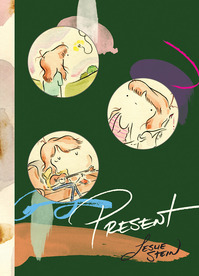“Don’t Swallow the Bitter Pill”: Present’s Leslie Stein on Simple Pleasures and Wanderlust
Main Art by Leslie Stein
Comics Features Leslie Stein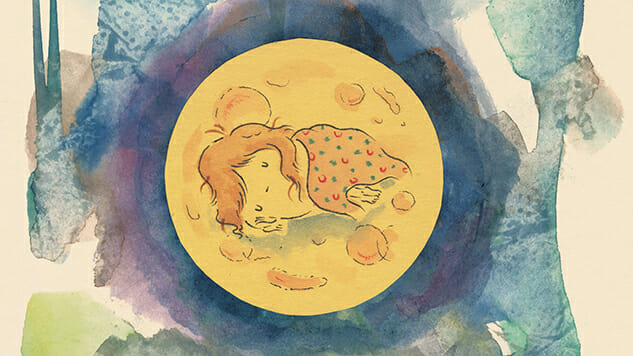
When I first read Leslie Stein’s Eye of the Majestic Creature in 2011, its psychedelic, autobio tale of a girl and her sentient guitar didn’t engage me. When Timeclock, part of the same series, came out last year, I found myself surprisingly invested in the book, although I hadn’t opened it with high hopes. What changed in the interim? Me? Or Stein? The answer is probably both of us.
I’m a little more patient now with comics that develop gradually and are not overly narrative-driven, which is definitely one way you could describe Stein’s work. It’s soft and loopy (both in the shapes she makes and in the wide-eyed way her autobiographical characters look at the world), and sometimes it doesn’t go anywhere all that specific. I also think she’s grown over the same period of time, and her new book, Present, out from Drawn & Quarterly, shows just how much. Collecting short strips that ran on Vice, the graphic novel is raw but never ugly—weird, warm, refined, delicate, softly precise and open-hearted, all at the same time. Maybe I’m a more forgiving person these days when it comes to accommodating the emotions and flaws of others, and Stein seems to have shivered off a few more layers of skin, bringing us closer to her very human core. Whatever did it, the book is great.
Stein answered Paste’s questions over email despite being in the middle of a book tour. ![]()
Paste: I really like the two different meanings of the title, because I feel like they’re equally important to what this collection of stories is about. Do you think it’s important to live in the present? How do you feel about gifts?
Leslie Stein: I think it’s a great skill to cultivate, being in the moment, looking at what’s around you, appreciating the tiny things that we often ignore. On the cover, there are three images of the main character… [in] one she is just looking at a bumblebee and how it flies around. It’s cheesy, but I derive great pleasure from these things, especially if other things in life aren’t going as we wished they would. The world is a scary place, but it can also be a beautiful place. Just put down your rectangle and go outside.
I love giving my best people gifts, but just when I see something around I think they would like or feel like making a thing. When it’s around a holiday, it’s often stressful and the choices one makes are morally and spiritually insignificant. Although I love Valentine’s Day actually. One year I just made valentines for all my single friends. Also, gifts are where you find them. An elegant glass of wine feels like a gift to me, love being put forth in a non-direct way, even if I’m paying.
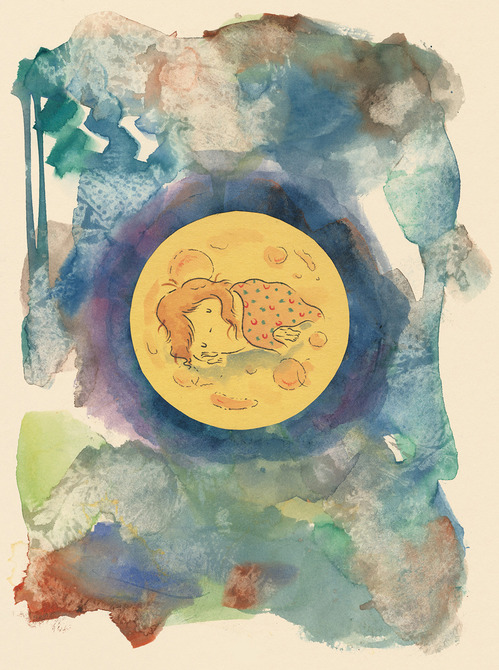
Present Interior Art by Leslie Stein
Paste: It’s been interesting to watch your style become more and more minimalist (and abstracted). What’s led you in that direction?
Stein: I think just changing up my drawing tools. Watercolor is so soft, and my line got softer and wispier to accommodate that. I really love [Wassily] Kandinsky and Paul Klee, and I love Charles Schulz and Doug Wright, so I’m marrying all of them together in a way. It’s been really liberating, I make sure I’m always trying a new experiment in regards to color, design, style and composition within each story.
Paste: At the same time, you use color much more now than earlier in your career. Why?
Stein: You are referencing the 10 years worth of black-and-white stories in the Eye of the Majestic Creature series. I wanted to make that series as consistent as possible, but of course the style was going to change given that I started it when I was 22! Jeez Louise. So yeah, the color comics came out maybe as a reaction to that and desire to play around with other materials and color.
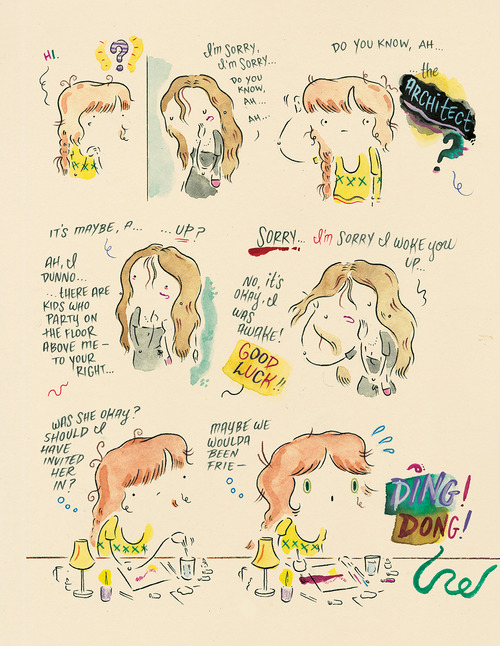
Present Interior Art by Leslie Stein
Paste: The lack of lines around your characters’ faces almost seems like a reflection of their openness to new experiences and their emotions bleeding out into the world. Would you say that description seems like you at all? You’ve also stopped using panels (or at least more clearly defined ones). Same reason?
Stein: The ultimate cartooning is expressing the most with the least. I wasn’t mature enough to do this earlier and was relying on a lot of detail and stippling in order not to hate myself. From what I can tell, people are getting the emotional significance in the character designs and reactions to each other, so I guess a line around the face just isn’t necessary here? But, yep! I think you are correct that there is a correlation to the openness of design in regards to the spirit of the pieces and the love I’m trying to portray to the reader.
Also, yes, that sums me up. I’m a very open-to-new-experience person. Of course, I change things around and mix experiences to enhance the stories, but these are all based on real events.
Paste: There’s a sketchbook-like quality to your work. How much do you plan ahead, thumbnail out, fix things, etc.? Is the spontaneity real or achieved through hard work?
Stein: It’s both. I write the comic out just to get a tight story and then kind of attack the page with very, very minimal penciling. My last book in this style, or predecessor to this style, Bright-Eyed at Midnight, I never penciled. I just started at the top right of the page and let things flow. Present is all the lessons I learned from that book, forming a more concrete, but still experimental, style.
Paste: You’ve lived on both coasts. Which one feels more like you?
Stein: Oh, I don’t know. I loved living in San Francisco, and I love living in New York. I grew up in Chicago, so I got some midwest in me for sure. I find the idea of living on the California coast somewhere someday very appealing and romantic.

Present Interior Art by Leslie Stein
Paste: You work nights, as a bartender. What are the advantages of a service industry job (as opposed to teaching, which seems to be the other way comics artists make a living)?
Stein: No homework! I leave work and I don’t think about it until I’m there again. I think teaching I’d have some sort of emotional investment and it might be hard to separate. I’ve substitute-taught kids [and] I liked that a lot. But college age is different. We’ll see what happens. I might someday.
Paste: When do you make most of your comics? Before you go to work or after you get off (or on your days off)?
Stein: On my days off, since I work only happy hour shifts now. I used to work during the day when I had to go in later.
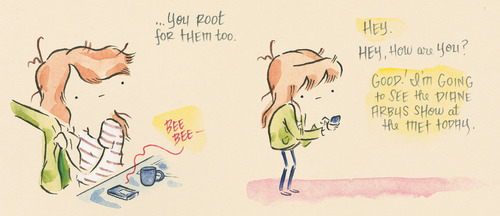
Present Interior Art by Leslie Stein
Paste: Tell me about your comics education: who was your most important teacher?
Stein: I don’t think you need to go to school to make comics. It’s probably a waste of money, you just need to do them. That said, I did. I wasted my father’s money. Poor guy. I really loved a teacher named Keith Mayerson. The best thing he ever said to me, and I let resonate and come back to is more of a life lesson, even though he meant it in regards to the art world, was: “Don’t swallow the bitter pill.” I’m still thankful for anything to come my way, one reader, one dollar, even after all these years.
